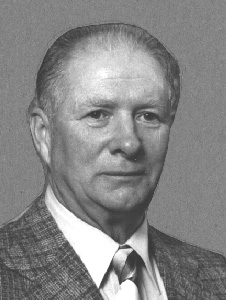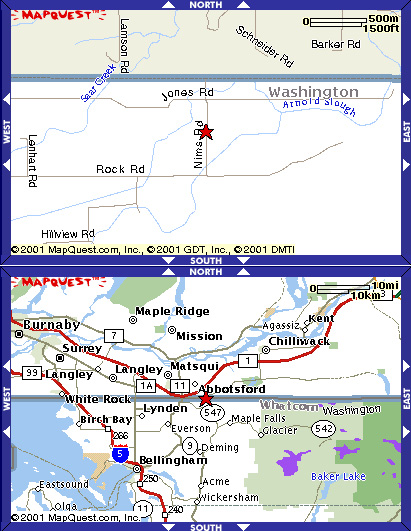
All of the nine children of our family were born in the farm home three miles east of Sumas on what is now called the Nims Road. The house was built about 1901 on 80 acres of land which my father had homesteaded or bought two years earlier. Like all rural homes of the time, we would now consider it quite primitive. It consisted of a kitchen and living-dining room on the lower floor and two bedrooms upstairs. A well worn trail lead to the outhouse some distance away.
As the family grew, an additional living room and bedroom were added to the lower floor and a pantry on the end of the kitchen. As there was no heat in this added room, it was seldom used except in warm weather. A large porch was adjoined the kitchen and a pitcher pump on the porch provided the only source of water. There was no plumbing in the house. When we got the cold north-eastern winds in winter, the pump would freeze and we would have to thaw it out with hot water.
The house was heated with a wood heater in the living room and a wood range in the kitchen. For light we used kerosene lamps in the house and kerosene lanterns in the barn. At about six years of age I was given the job of filling all of the lamps and lanterns each afternoon after coming home from school.
Each Monday morning mother would put a boiler full of water on the wood range and heat it for washing. She had a Maytag washer with a gasoline engine which was kept outside on the porch. About the time that I entered high school the electric line was extended to the farms in the area and we had the house and barn wired for electricity. Mother got an electric range but still did most of her cooking in the wood range. All water was still heated on the wood range.
The house was built facing a wagon road along the slough which ran across the south-east corner of the farm. At a later time, a county road was built across the west edge of the farm (the Nims Road), and an east-west road was built out of Sumas which divided the farm and ran almost to the mountain on the east. The north line of the farm was the Canadian border, but at that time little attention was paid to the border and farmers shared work across both sides of the line. When prohibition was voted in, bootlegging was common in the area.
I do not recall any full blooded Indians living in the area, but the area along the slough had obviously been actively used by Indians as when land was first plowed the Indian relics were so common that we usually did not even bother to pick them up. I do remember a box of stone tools for grinding grain and lots of tomahawks and arrow heads which had been saved, but which were so common that we felt they had no value. The slough at one time had been a major tributary of the Frazer River, and as such no doubt had lots of salmon and other fish in season, which probably accounted for the Indian activity.
Like most other farmers in the area, we had one team of horses to provide power for farming Ours were grey Percheron horses named Dorothy and Bessie. In addition, we had a riding horse called Babe, which pulled our one horse buggy, our source of transportation. Before the time I entered school we purchased a used Dodge car and my folks depended on used cars from that time on.
Our only source of income was from the farm. We had a small dairy of about 30 cows which produced milk for butter and cheese and provided us plenty of raw milk. There were no grade "A" dairies in the area which qualified for selling fresh milk. We raised a number of crops; wheat, oats, vetch and clover seed were raised on the larger fields. Often we raised string beans for the cannery and at least one year raised sugar beets. And, we raised lots of fruit, potatoes and other vegetables for own use which we canned or otherwise preserved for year round use as we seldom bought them at a store.
Harvesting the beans was a family affair. My mother and all of the children who were not working on other projects would pick beans most of the day, and late in the afternoon we would run them over the sorting table where we had to cull out all of the beans which were too large for #1 beans. We then put them in grain bags and a truck came by all of the bean fields to pick them up for the cannery. One highlight of picking beans I remember is that once a year we would have the milk truck driver bring us a gallon of ice cream packed in dry ice. As we had no refrigeration we had to eat the whole gallon before it melted.
Most of our grain and seed was delivered to a general merchandise store in Sumas after it was harvested. We were credited for it as it was delivered, and purchased merchandise from the store through the year against this credit. Little cash was handled. Most of the cash we handled came from the cream checks each month. A good share of it went for interest and taxes on the farm, and what little was left was carefully hoarded for essential uses. I remember my mother once telling me that she was allowed to spend one dollar on each of the children for Christmas presents.
A number of close relatives lived in the area. Grandma and Grandpa Buell had a small farm at the east end of the Rock Road next to the mountain. The Rock Road was at the south end of the Nims Road and continued west to Sumas. They had built a one room log house at first, and later built a two room lumber house next to the log house. Grandpa died when I was very young, but Grandma was still living well after I graduated from college. The youngest of our children would go over to grandma's place for Sunday school and we would each get a cookie. Their son Harry did not marry and lived with Grandma Buell.

Next to them to the west lived uncle Bob Bean and Aunt Mable (Mable Buell) and their son Russell. They had a small farm of about 20 acres and Bob got work off the farm when he could.
Joining them on their west and at the end of the Nims Road was uncle Fred Nims and Aunt Laura. Fred was dad's brother and Laura was mother's sister. Fred was a master builder and built many barns in the area as well as some houses. After living many years in a small house, Fred built a large modern home on the farm and his son Don moved into the small house. Fred and Laura's new house was the first house in the area to have inside plumbing.
Aunt Millie and Uncle Earn Nims lived on a farm joining ours on the east. Like my dad, Earn built their house along the slough, however after Fred had built his new house, Fred hired him to build them a new house along the Jones road which had been constructed since Earn built his first house. Earn also had a small dairy and raised some crops including raspberries and beets for the cannery where my brother Buell and I worked some in the summers.
Mother had two sisters which I did not know much about. Her sister Frances was married to Charley Robertson and they had two sons, Harry and Neil. They lived most of the time in Canada and Charley was always on the edge of the law. Charley was alleged to have been a master bootlegger and made his money in any way he could. I remember at one time it was understood that he would be arrested if he ever came over to this side of the border, but when Grandma Buell died they allowed Charley and Frances to come over to attend the funeral without making an arrest.
Mother's sister Louise married and they lived at New Westminster in British Columbia. My mother and I took the train to visit her once but that is the only time I remember seeing her.
My work on the farm really began when I was about eight years of age when I started milking three cows each morning and evening. From there it was not long until I took over some of the feeding of the cattle and other chores around the place. By the time I was in high school I was harnessing the horses and working them in the field. I remember when I was in high school the principal hired me and the team of horses to plow the school athletic field. He was agreeable to paying me the two dollars a day which I asked for my work but objected to having to pay two dollars a day for the team of horses.
My older brothers and sisters walked to the one room school on Rock Road, but by the time I was of school age a school bus took us to the Sumas school and later to the Sumas-Nooksack High School from which I graduated in 1935. Because of my heavy work schedule on the farm and the distance from school I did not participate in many extra curricular events. I did run the mile on the track team but my time was nothing spectacular.
Before I entered college my folks had purchased a small home in Bellingham for their retirement, so I lived there and enrolled in the Bellingham State Normal School (renamed the Western Washington State College of Education in 1937). While attending college, I learned that I could earn one dollar a week by joining the National Guard, so I enlisted and served for the last three years of college where I became the company clerk of Co. "K", 161st Infantry regiment. I was not considering a military career but learned that I could become an Army Air Corps officer through the pilot training program. About six weeks before college graduation I received the letter from the Department of the Army that I had been selected for flying cadet training and was directed to report for duty two weeks after graduation.
During my last year in college I met Betty Hogg whom I married in August 1941. We have enjoyed a happy married life ever since.